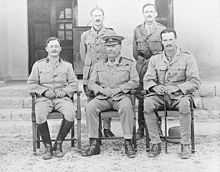Percy Sykes

Brigadier-General Sir Percy Molesworth Sykes KCIE, CB, CMG (28 February 1867 – 11 June 1945) was a soldier, diplomat, scholar and historian,[1] with a considerable literary output. He wrote historical, geographical, and biographical works, as well as describing his travels in Persia.
History
Sykes was born in Brompton, Kent, England the only son of Rev. William Sykes and his wife Mary Molesworth, and educated at Rugby School and the Royal Military College, Sandhurst.[2] He was commissioned into the 16th Lancers, but transferred to the 2nd Dragoon Guards in 1888. He was posted to India and made several journeys through Persia and Baluchistan. During the Second Boer War he served in the Intelligence Department[3] and was wounded in the leg.[4] He did a secret mission in the November of 1892 where he went to Uzbekistan the Trans-Caspian Railway.[2] The Royal Geographical Society awarded him the Back grant in 1899 and the Patron's Gold Medal in 1902.[5] In 1902 he transferred to the Indian Army. Over the next few years he made extensive journeys in the Middle East and was appointed consul-general for Khūzestān in 1906.
In 1915, Sykes was knighted.[4] While stationed in Persia he was given the temporary rank of Brigadier-General, he raised[4] and was placed in command of the South Persia Rifles.[6] His forces, consisting of some four hundred and fifty men, supported the Russians at Isfahan against Bakhtiaras[6] and restored some order to the country. Once stationed at Isfahan, Sykes used numerous excuses to remain, including a supposed Russian request that the South Persia rifles be used as a garrison for Isfahan.[6] By 1917, numerous British authorities were calling for his removal save Lord Curzon.[6] Despite this, Sykes was finally recalled in 1918.[6]
Sykes retired from the army in 1924, retaining the honorary rank of Brigadier-General. From 1932 until his death he was honorary secretary of the Royal Central Asian Society, now known as the Royal Society for Asian Affairs. The society has in its gift an award called The Sir Percy Sykes Memorial Medal.[7]
In 1902 he married Evelyn Seton, eldest daughter of Colonel Bruce Seton of the Royal Engineers and they had six children. His daughter Rachel married Sir Patrick Reilly the diplomat. Sykes was the nephew of Richard Sykes the rugby player who founded towns in America and cousin of Sir Alan Sykes, 1st Baronet MP for Knutsford, Cheshire.
Publications
- Ten Thousand Miles in Persia (John Murray - 1902)[2]
- The Glory of the Shia World (Macmillan Publishers - 1910)[2]
- Lectures delivered to the Persia Society, 1913-1914. (Morrison & Gibb - 1914)
- A History of Persia (MacMillan - 1915)[2]
- Through Deserts and Oases of Central Asia (MacMillan - 1920)
- A History of Persia - 2nd edition (MacMillan - 1921)
- Persia (Oxford University Press - 1922)
- The Right Honourable Sir Mortimer Durand -a biography (Cassell & Co. - 1926)
- A History of Persia - 3rd edition (MacMillan - 1930)
- A History of Exploration (George Routledge & Sons - 1934)
- The Quest for Cathay (A. & C. Black - 1936)
- À La Recherche du Cathay (Payot, Paris - 1938)
- Explorers All, Famous Journeys in Asia (George Newnes - 1939)
- The Story of Exploration and Adventure. Edited by Sir Percy Sykes. (George Newnes - 1939)
- A History of Afghanistan (MacMillan - 1940)
- A History of Exploration (Routledge & Kegan Paul - 1949)
- A History of Persia ... 3rd edition, with supplementary essays. . (MacMillan - 1958)
Notes
- ↑ Shapur I, Shapur Shahbazi, Encyclopaedia Iranica, (20 July 2002).
- ↑ 2.0 2.1 2.2 2.3 2.4 "A History of Persia". World Digital Library. 1921. Retrieved 2013-10-01.
- ↑ Percy Molesworth Sykes, Y.M. Choueiri, A Global Encyclopedia of Historical Writing: A-J, ed. Daniel R. Woolf, (Routledge, 1998), 871.
- ↑ 4.0 4.1 4.2 Hugh Leach and Susan Marie Farrington, Strolling About on the Roof of the World: The First Hundred Years of the Royal Society for Asian Affairs, (Routledge, 2003), 185.
- ↑ "Royal Geographical Society" The Times (London). Saturday, 15 March 1902. (36716), p. 12.
- ↑ 6.0 6.1 6.2 6.3 6.4 Bureaucracies at War:The British in the Middle East in the First World War, John S. Galbraith and Robert A. Huttenback, National and International Politics in the Middle East: Essays in Honour of Elie Kedourie, ed. Edward Ingram, (Routledge, 2013), 117-119.
- ↑ "RSAA Awards". RSAA. Retrieved 3 June 2013.
References
- Who’s Who
- Meyer, Karl E. and Shareen Blair Brysac, Kingmakers: the Invention of the Modern Middle East, W.W. Norton, 2008.
- Wynn Anthony, Persia in the Great Game – Sir Percy Sykes: Explorer, Consul, Soldier, John Murray, 2003
External links
- SYKES, Sir Percy Molesworth, Encyclopædia Iranica
- Royal society for Asian Affairs
- A report on the mission of Percy Sykes in Kashghar in 1915, and his photos from there
- Works by Percy Sykes at Project Gutenberg
- Works by or about Percy Sykes at Internet Archive
|